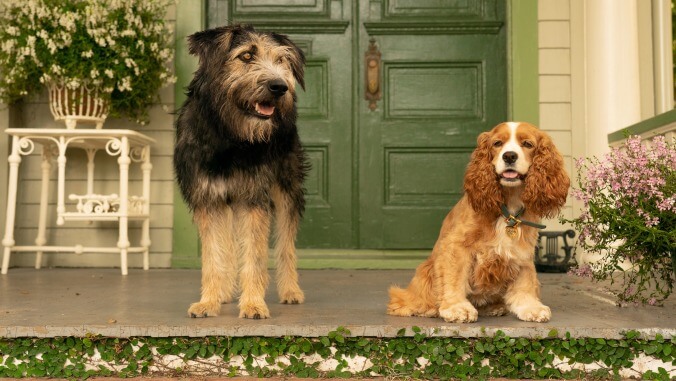The new Lady And The Tramp feels like a ’90s update of a ’50s classic


With remakes of The Lion King, Beauty And The Beast, and Aladdin topping the box office despite their rather dubious artistic qualities, the ’90s have proven to be a particularly fruitful era for Disney. The Mouse House’s latest live-action do-over capitalizes on nostalgia for that decade in a different way. Though the new Lady And The Tramp is based on a classic animated film from 1955, director Charlie Bean (The Lego Ninjago Movie) reimagines it as a wacky, wholesome family adventure flick that wouldn’t feel out of place in the Clinton era. The animal hijinks call to mind Babe at their best and Air Bud at their worst. Meanwhile, the love story between upper-class cocker spaniel Lady (Tessa Thompson) and wry street dog Tramp (Justin Theroux) gets a sparky oil-and-water update straight out of a ’90s rom-com.
The appreciably color-blind casting and somewhat stagey look even recall the made-for-TV movie musicals that used to air on ABC under The Wonderful World Of Disney banner, like 1997’s Cinderella and 1999’s Annie. The first live-action Disney remake to debut exclusively on the new Disney+ streaming platform, Lady And The Tramp often has the feel of an expensive made-for-TV movie. Taken on its own, it’s a perfectly fine if somewhat generic kid’s film that aims to satisfy young viewers but won’t grate the nerves of any adults who might also be in the room. The problem is that it’s remaking one of the most gorgeous, mature films in the Disney animated canon, and doesn’t begin to rise to that high water mark.
The big hook of this new version is that it features real canine stars, a surefire way to pique the interest of the dog lovers who are keeping all those Dog’s Purpose movies alive. The advantage of using actual pooches is made clear from the sweet prologue, where “Jim Dear” (Thomas Mann) gifts his wife “Darling” (Kiersey Clemons) an adorable puppy version of Lady, who pops out of a hatbox and playfully rolls around her dog bed. Unfortunately, the cute real-life dogs in Lady And The Tramp have to speak, and that means their faces are frequently augmented with unsettling CGI. There are certain shots where entire animals seem to be digitally inserted, too. Trying to wrap your mind around what you’re looking at sometimes sends the film out of its quaint turn-of-the-century America setting and firmly into the uncanny valley.
You sort of get used to it after a while and Bean tries his best to obscure the limitations of the effect with shadow and darkness. Still, each scene of a dog talking in bright daylight jars anew. The plasticity reaches its nadir when Darling’s disparaging Aunt Sarah (Yvette Nicole Brown) brings her two cats for a visit. While the film mercifully does away with the racist “Siamese Cat Song” from the original, it replaces it with a forgettable, jazzy number that underscores an even more forgettable sequence of two fully CGI cats wreaking weightless havoc. The film gets a better musical moment (and some slightly better CGI) in Janelle Monáe’s performance of “He’s A Tramp.” As the worldweary Pekingese Peg, Monáe makes probably the best impression of any of the canine supporting cast, with Sam Elliott’s Trusty and Ashley Jensen’s gender-flipped Jock feeling disappointingly underutilized.
After an uneasy start, Lady And The Tramp fares better in its second half as it zeroes in on the star-crossed love story between Tramp and Lady, who’s displaced when Jim Dear and Darling welcome a new baby into the house. Though the remake lightly reworks several plot points from the original, it knows not to mess with the iconic spaghetti scene, which is once again a high point. Screenwriters Andrew Bujalski (Support The Girls) and Kari Granlund also offer a fun new sequence where Lady and Tramp sneak onboard a steamboat and watch a jazz sextet perform the 1913 hit “You Made Me Love You.”
It’s one of the few moments where the film embraces the specificity of its setting. For the most part, however, the time period feels arbitrary, especially given the modern vibe of Thompson and Theroux’s voice work. Lady is brassier and more outspoken in this version, while Tramp is reimagined as less of a charming playboy and more of a cynical loner—the better to fit them both into ’90s rom-com archetypes. In place of the original’s specific social commentary and exploration of class, the new version offers more generic themes of family loyalty versus independence. It’s still wholesome and heartwarming, but also much less poignant and complex, despite being about 30 minutes longer.
Watching the remake over-explain every joke and dramatic beat only increases one’s appreciation for how the original trusted its young audience to understand subtext, satire, and emotional nuance. Bean only occasionally nods to the clever dog’s-eye point of view of the original, where Jim Dear and Darling were seen mostly from the knees down; here, the humans are much more active players, with mixed results. This Lady And The Tramp deserves credit, certainly, for its more diverse casting and the outright removal of the racist elements that marred the original. Mostly, the film benefits from the lower stakes of a streaming-platform release. It’s debuting, in fact, alongside its 1955 predecessor on Disney+. That makes it the perfect compare-and-contrast starter kit for parents and kids everywhere.